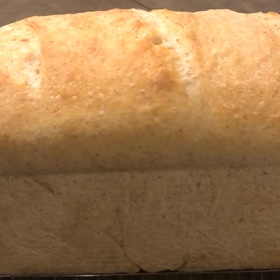Ingredients
Sourdough starter:
1 cup starter
1 cup water
1 cup whole wheat flour
Bread:
1 1/2 cups water
3+ cups bread flour
2 tsp. salt
kitchenaid with dough hook
spray bottle
tea towel
banneton
4x9.5 inch bread pan
Description
This is a long process, but it never fails to produce a sour loaf.
If you want to maintain a sourdough starter instead of creating a new one when you want sourdough, there are instructions in the notes. Whole wheat starter is finicky and more likely to die, which is why I personally don't maintain one.
Directions
Day 1: Make the sourdough starter. Cover with plastic wrap and refrigerate for at least 2 days, and up to a week. You will know for sure when you need to move to the next step based on the amount of alcohol it has produced. If it is an inch or more, move on. If it turns dark brown or black, you've waited too long and the yeast is dead.
Day 2: Pull the starter out. Let it warm up and become bubbly. 
Either stir in any alcohol or dump it out. Measure out 1 cup and discard the rest. Feed it 1 1/2 cups water, and 3 cups of bread flour. Mix thoroughly, cover with plastic wrap, put in the fridge, and let sit overnight.
Day 3: Pull the dough out and let it sit at room temperature 4-5 hours. It should look bubbly and puffy.
Add the salt. Incorporate enough bread flour to make a doughy ball.
Turn out onto a lightly floured board and knead enough to make a relatively smooth ball. It shouldn’t take much. 
Put into a banneton and do 4 rest/fold sessions with 30 minutes in between.
Turn out onto your floured board, press out thin and try to de-gas the dough as much as possible. 
Roll up and pinch the seam into the roll. Put in your pan seam side down.
If it comes more than 3/4 of the way up, cut some off to bake separately or toss.
Snip or cut some slashes in the top, spritz with water, cover with a tea towel, and let rise in a cool room until doubled, 1 1/2-4 hours.
It should be somewhere between the top of the pan and 1 inch from the top of the pan at the tallest spot. (The tip of your thumb to the first knuckle.)
Preheat your oven to 350 degrees.
Spritz your loaf with water, bake 30 minutes, spritz again, and bake another 10-15 minutes. Sourdough can be very pale. If you would like a browner look, brush it with a bit of milk before it goes in, and again before the last 10-15 minutes.
Turn out onto a cooling rack, wrap in a tea towel, and let cool completely before slicing or putting away. 
Bread without a pan:
The directions aren’t really much different. After de-gassing, shape your dough, put it on a parchment or silicone mat lined sheet, let rise and bake alongside your other pan or alone. If your loaf is small or you made rolls, you may only need a 25-30 minute bake time total.
In a pullman pan:
Using a pullman pan allows you to make perfectly shaped sandwich bread.
When you put the dough in the pan, it will need to come no higher than half way up. Trim off what you need to accomplish this and bake it separately or toss.
Let rise to 1 inch from the top. If it rises high enough to touch the lid, use scissors to trim dough off the top.
Spritz with water, put the lid on, and bake for 45 minutes.
Notes
Banneton And Folding Instructions
*When it comes time to dump out excess starter- keep it instead. You will need to feed the starter 1-2 times a week; you will know when you need to feed it by the amount of alcohol it has produced. If there is an inch or more, feed it. Keep 1 cup of the starter to feed and use the other cup in the above recipe. Or if you don't want to make bread yet, discard it.
Feeding:
Feed it 1/2 cup of bread flour, 1/2 cup of whole wheat flour and 1 cup of water. Stir thoroughly and refrigerate 2 days to a week.
If the alcohol in your starter darkens in color from amber or light brown to dark brown or black, the yeast is dead and you'll want to start over.
